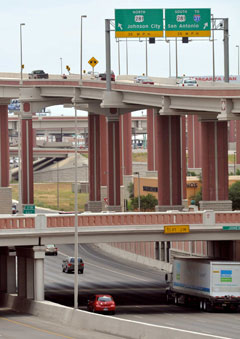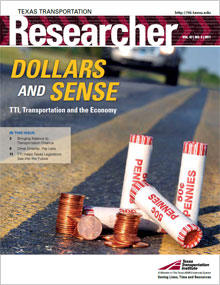TTI Assesses Loop 410 Improvements in San Antonio

Accountability. Performance measures. “Bang for the buck.”
We hear these terms a lot these days about our transportation system. Knowing how to maximize the return on our transportation dollar is vital at a time when budgets are shrinking but commuter needs continue to grow.
In 1960, San Antonio’s population was 587,718. Loop 410, which opened to the public in 1966, was the first planned and constructed metropolitan loop in Texas. The loop was designed to handle 40,000 vehicles per day (twice the anticipated volume in the 1960s) and facilitate the growing trend of suburban commuting.
By 1995, however, 200,000 vehicles per day traveled the loop, and each San Antonio resident sat in traffic about 24 hours per year due to the congestion. To combat this reality, the Texas Department of Transportation (TxDOT) spent over $900 million on infrastructure improvement projects along the loop. The improvements multiply the loop’s original vehicle capacity by a factor of 10.
“The Loop 410 projects afforded us a unique opportunity to assign a real value to the improvements TxDOT made along the corridor,” explains Texas Transportation Institute (TTI) Research Engineer Steve Venglar.
To assess the projects’ economic benefits to San Antonio, TTI researchers looked at local trackable metrics, like impact on land use and business sales, along with regional impacts, including how jobs were affected. Other factors examined included
- reduced travel time,
- improved travel time reliability,
- vehicle operating costs (including fuel consumption),
- driving safety,
- air quality and
- accessibility.
“We also gathered anecdotal evidence from local companies and businesses within nine zip codes along Loop 410 to assess their perceptions of improvements,” says Venglar. “In general, business owners viewed the changes as positive, and many noted improvements in commute times.”
Conservatively speaking, the assessment calculated a 3-to-1 return on infrastructure improvement dollars invested, with some 12,000 new jobs created by the project. By 2035, commuter savings will likely accrue to $1.2 billion, and fuel savings could rise to $626 million. Tax-base contributions will reach an estimated $109 million by 2020. To increase the accuracy of the predicted benefits of the improvements, TTI suggests continued evaluation using a more comprehensive analysis after the project has been in place for several years.
“TTI’s work has helped us clarify the long-term benefits of our work on Loop 410,” says Clay Smith, director of transportation planning and development for TxDOT’s San Antonio District. “Knowing in advance how projects like this benefit the system helps us better plan and execute other such projects in the future.”
